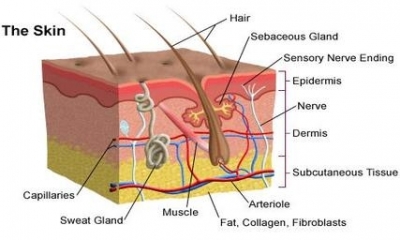
There is one system that extends over the entire surface of your body. Known as the integumentary system, it consists of the skin, hair and nails, which together cover and protect the other body systems against the outside world.
The skin is the largest organ of the body, wrapping it in a waterproof and germproof barrier. It is also essential in helping you to touch and feel things around you, to control the body’s temperature, and to filter out harmful rays from the Sun. Hair and nails provide extra protection for some parts of the body. They grow from the skin and are made from dead cells of a tough substance called keratin.
Skin and hair
The skin has two main layers. The epidermis is the thin, protective outer covering, made up mostly of dead, scaly cells. Beneath it lies the thicker dermis, which is rich in blood vessels and nerve endings to sense pressure, temperature, and pain. Strands of bendy hair cover almost all the body’s surface. Hair grows from follicles, which are deep pits in the skin.
Epidermis
This is the thin, protective outer layer of skin.
Dermis
The dermis is a thick layer packed with glands, nerves, and touch sensors.
Fat layer
This inner lining of fat stores energy and keeps in body heat.
Skin removal
The skin is removed by new cells pushing to the surface where they flatten and die, turning into tough keratin.
Hair
Millions of short hairs grow out of the skin’s surface.
Hair follicles
Hair grows out of pockets called follicles.
Erector muscle
This tiny muscle pulls hairs upright when the body is feeling cold.
Pacinian corpuscles
These receptors at the base of the dermis detect vibrations and pressure.
Sweet gland
These coiled glands ooze moisture on to the skin’s surface where it evaporates to keep the body cool.
Sensory receptors
Different types of receptor react to heat, cold, or touch.
Oil gland
These glands produce a substance called sebum to soften hair and skin.
Cornified layer
The skin’s outer layer is mostly dead and dying keratin-filled cells.
Base layer
New skin cells are formed in the base of the epidermis, ready to move up to the surface.
Finger layer
Fingerlike bulges hold the epidermis in place – and create the ridges that make fingerprints.
Nerves
These networks carry signals between touch receptors and the brain.
Artery
This supplies oxygen and nutrients to the skin.
Protective shield
Skin protects the body, while being flexible enough to let you move around easily. The hair on your head keeps you warm and gives the scalp an extra layer of defence. Fine hairs on the rest of your body make you more sensitive to touch.
Nail structure
Nails are hard plates of dead cells that protect the ends of your fingers and toes. They also help you to grip and pick things up. New cells grow in the root of the nail, and as these cells move forward, they harden and die, it takes about six months for cells to move from the base of a nail to the tip.
Picture Credit : Google

